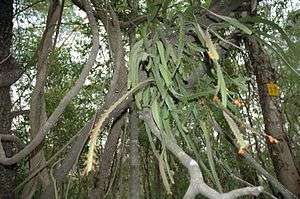Southern Andean Yungas
The Southern Andean Yungas is a tropical and subtropical moist broadleaf forest ecoregion in the Yungas of southwestern Bolivia and northwestern Argentina.[1]
| Southern Andean Yungas | |
|---|---|
 Lepismium monacanthum in Calilegua National Park | |
| Ecology | |
| Biome | Tropical and subtropical moist broadleaf forest |
| Borders | List
|
| Geography | |
| Area | 61,100 km2 (23,600 sq mi) |
| Countries | Bolivia and Argentina |
Setting
The ecoregion occurs in elevations ranging from 800 to 3,000 metres (2,600 to 9,800 ft).[1]
Climate
This ecoregion has a subtropical highland climate. The climate is influenced by trade winds that bring about 2,500 millimetres (98 in) of rain per year.[1]
Flora
The Southern Andean Yungas consists of a mesic evergreen forest, with trees typically less than 15 metres (49 ft) tall. Between 1,200 to 2,500 metres (3,900 to 8,200 ft) the forest is dominated by Andean alder (Alnus acuminata) and mountain pine (Podocarpus parlatorei). At lower elevations these species mix with other trees, especially Lauraceae and Myrtaceae.[1]
Fauna
Many tropical species find the southern limit of their range in this ecoregion.[1]
Mammals that may be found here include the white-lipped peccary (Tayassu pecari), the collared peccary (Pecari tajacu), and the South American tapir (Tapirus terrestris). Cats include the jaguar (Panthera onca), puma (Puma concolor), margay (Leopardus wiedii), and jaguarundi (Puma yagouaroundi).[1]
Birds with ranges restricted to this ecoregion include the red-faced guan (Penelope dabbenei), Rothschild's swift (Cypseloides rothschildi), and the rufous-throated dipper (Cinclus schulzi).[1]
Natural areas
References
- "Southern Andean Yungas". Terrestrial Ecoregions. World Wildlife Fund.